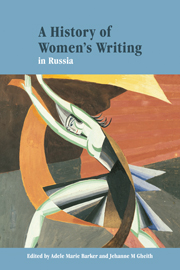Book contents
- Frontmatter
- Contents
- Notes on contributors
- Acknowledgments
- Note on transliteration
- List of abbreviations
- Introduction
- 1 Women's image in Russian medieval literature
- 2 Sappho, Corinna, and Niobe: genres and personae in Russian women's writing, 1760–1820
- 3 The inexperienced muse: Russian women and poetry in the first half of the nineteenth century
- 4 Women of the 1830s and 1850s: alternative periodizations
- 5 “A particle of our soul”: prerevolutionary autobiography by Russian women writers
- 6 The women of Russian Montparnasse (Paris, 1920–1940)
- 7 Women in Russian Symbolism: beyond the algebra of love
- 8 The eastern path of exile: Russian women's writing in China
- 9 Realist prose writers, 1881–1929
- 10 Women and gender in post-symbolist poetry and the Stalin era
- 11 Writing the female body politic (1945–1985)
- 12 In their own words? Soviet women writers and the search for self
- 13 Women's poetry since the sixties
- 14 The persistence of memory: women's prose since the sixties
- 15 Perestroika and post-soviet prose: from dazzle to dispersal
- Bibliographical guide to writers and their works
- Guide to further reading
- Index
11 - Writing the female body politic (1945–1985)
Published online by Cambridge University Press: 22 September 2009
- Frontmatter
- Contents
- Notes on contributors
- Acknowledgments
- Note on transliteration
- List of abbreviations
- Introduction
- 1 Women's image in Russian medieval literature
- 2 Sappho, Corinna, and Niobe: genres and personae in Russian women's writing, 1760–1820
- 3 The inexperienced muse: Russian women and poetry in the first half of the nineteenth century
- 4 Women of the 1830s and 1850s: alternative periodizations
- 5 “A particle of our soul”: prerevolutionary autobiography by Russian women writers
- 6 The women of Russian Montparnasse (Paris, 1920–1940)
- 7 Women in Russian Symbolism: beyond the algebra of love
- 8 The eastern path of exile: Russian women's writing in China
- 9 Realist prose writers, 1881–1929
- 10 Women and gender in post-symbolist poetry and the Stalin era
- 11 Writing the female body politic (1945–1985)
- 12 In their own words? Soviet women writers and the search for self
- 13 Women's poetry since the sixties
- 14 The persistence of memory: women's prose since the sixties
- 15 Perestroika and post-soviet prose: from dazzle to dispersal
- Bibliographical guide to writers and their works
- Guide to further reading
- Index
Summary
She wore a pinafore when she cooked their meals, and to look at her one would think that she had never known any other life but that of a happy housewife bustling about her own home.
Life turned out to be full of happiness and wonders. Love had transformed Lena: she had a different walk and posture, her voice had become deep and cooing, and her eyes, their colour enhanced, seemed to have a secret lurking in their languid depths. She glowed with jubilance, men turned to look at her in the street, and she glowed all the more.
vera panova, The TrainThe visual propaganda of Socialist Realism has accustomed us to the spartan female body of Stalinism — the stern face, strong physique, plain dress, and powerful forward motion of Vera Mukhina's famous statue of the collective farm worker. Her pairing with an equally muscle-bound, action-packed male worker accentuated both her likeness and subservience to a stereotypically masculine model. In the Stalinist mindset, it seemed, the good body was the hard body, the most desirable mien that of energetic commitment, and the correct attire strictly functional. Much like Nazi Germany and fascist Italy, an industrializing, militarizing Soviet Union relied on such uniform regimentation to fashion its human material into productive tools and eventual soldiers.
We know now that these visions of the body were not even then monolithic.
- Type
- Chapter
- Information
- A History of Women's Writing in Russia , pp. 225 - 242Publisher: Cambridge University PressPrint publication year: 2002
- 1
- Cited by



